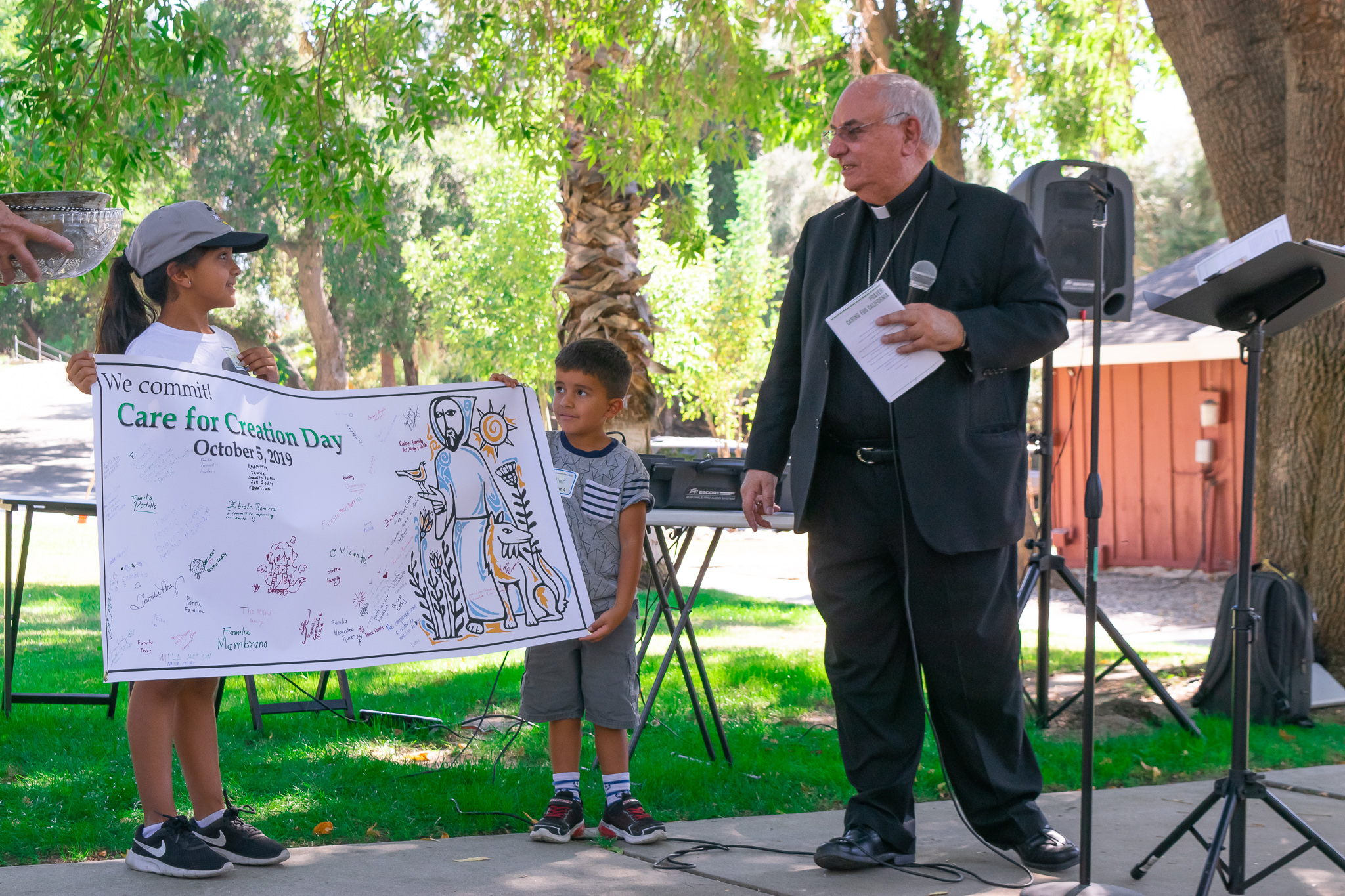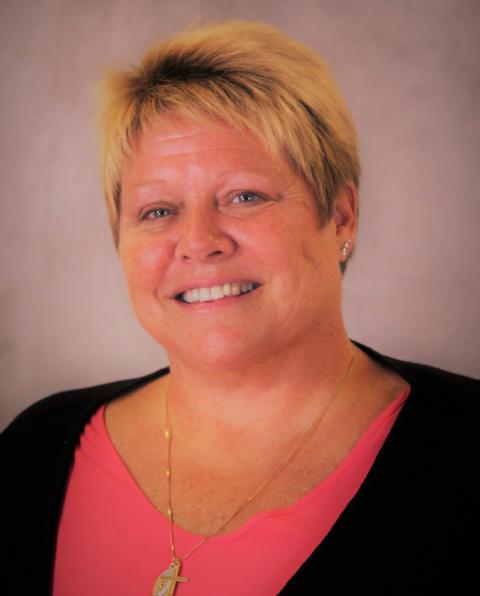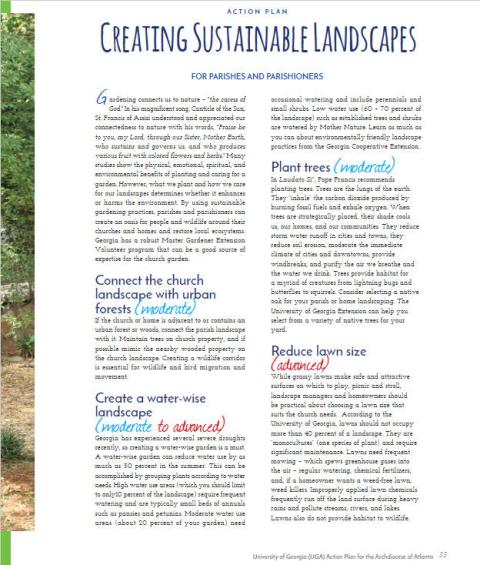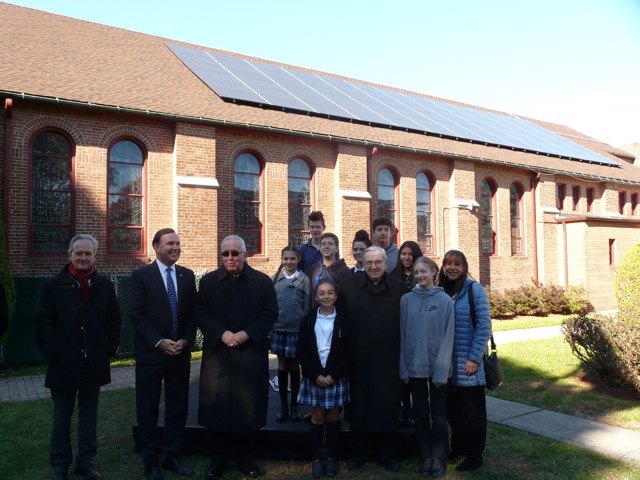
Two children display a poster of youth environmental commitments to Bishop Gerald Barnes as part of Care for Creation Day on Oct. 5 in the Diocese of San Bernardino, California. (Courtesy of the Diocese of San Bernardino)
On Oct. 4, the feast of St. Francis of Assisi, the Atlanta Archdiocese celebrated its fourth annual Green Mass, a day to give thanks for God's creation and offer a blessing for people who work in areas of environmental protection and sustainability.
Three days later, Kat Doyle, among the organizers of the ecological liturgy at the historic Catholic Shrine of the Immaculate Conception, got in her car and headed two hours west to Birmingham, Alabama. That night she attended a local parish's own Green Mass, an attempt to initiate the sort of ecological activity in that diocese that its members saw already under way in Atlanta.
"The movement's growing," said Doyle, the director of justice and peace ministries for the Atlanta Archdiocese. And as more and more parishes and dioceses start to consider their own creation care ministries, "they look for the places who are already doing the work."
Just five months after Pope Francis released his June 2015 encyclical "Laudato Si', on Care for Our Common Home," the Atlanta archdiocese released its own Laudato Si' Action Plan. Commissioned by Archbishop Wilton Gregory, now in Washington, D.C., and compiled with the help of scientists at the University of Georgia, it lays out a blueprint to turn the papal teaching document into realizable actions within parishes, schools and pretty much every corner of the largest Catholic diocese in the South.
"We're getting there," Doyle said. "We're certainly not there yet."
The challenges of scaling up and speeding up sustainability efforts in an age of rapid climate change are not unique to Atlanta, or even the U.S. Catholic Church. Climate scientists have said global fossil fuel emissions must be cut by 45 percent by 2030 in order to provide the planet a chance to stave off the worst threats to human life and wildlife alike that accompany rising temperatures worldwide.
Related: Catholics urge action as UN report forecasts climate crisis in coming decades
While the Catholic Church got its prompt from the pope, the planet received its own rush delivery order for substantial climate action that same year in the form of the Paris Agreement.
Both documents have animated much action. But neither has so far provided the spark to activate a pace and scale of climate-related actions matching the math to the demands of the science: Under the Paris climate pact, limiting average temperature rise as low as 1.5 degrees Celsius.
Both Laudato Si' and the Paris Agreement will turn five in 2020, which will also mark the 50th celebration of Earth Day.
Advertisement
Within the U.S. Catholic Church, efforts to increase both pace and scale took a sizable step this summer during a conference at Creighton University in Omaha, organized by the Catholic Climate Covenant. There, upwards of 200 people dedicated to the care for creation tenet of Catholic social teaching met one another, shared ideas and brainstormed ways to expand their efforts with the wider Catholic community.
In the four months since, organizers and staff at Catholic Climate Covenant have parsed through the notes and feedback from eight ministry tracks (adult faith formation, energy management, creation care teams, advocacy, higher education, young adults, school education, liturgy) and two caucuses (Hispanic Catholics and environmental justice) to chart a plan forward. The early work has yielded goals for each area, divided into actions that can be done relatively quickly; actions requiring additional time, input and funding; and "dream" actions that would entail new resources and staff.
"It's exciting," said Dan Misleh, Catholic Climate Covenant executive director. "It's a little daunting, but we're certainly committed to trying to move the ball forward in each of these areas."
Follow-up gatherings at Creighton in 2021 and 2023 will evaluate progress and push efforts at environmental stewardship onward.
As work begins on the first set of goals, Covenant staff have begun discussions on how best to take advantage of the Laudato Si' fifth anniversary. To leverage that moment into more concerted efforts on creation care within the U.S. Church.
Sharing ecological successes
One element that has proven key to increased action has been awareness of what others are doing and especially awareness of what's working, with an eye toward replicating.
For an example, look no further than the Covenant's Catholic Energies program. Before the Creighton conference, it had roughly 30 projects in the pipeline. After presentations there on the energy projects initiative, and following press coverage of solar installations at a Virginia parish and the Archdiocese of Washington, D.C., Catholic Energies now has around 100 inquiries at different phases.
"It's a huge role," Misleh said of awareness building. "Nobody likes to be the first. They want to make sure that it works."
In the feedback from the Creighton conference, the Covenant heard over and over again a desire for the D.C.-based non-profit to become more of a clearinghouse for resources and examples of effective projects and programs. It already had a store of liturgical guides and backgrounders about Catholic teaching on creation care. It's looking to expand to offer additional ecological resources for adult faith formation and school education, a version of the U.S. Environmental Agency's Energy Star for Congregations workbook, and best practices for creation care teams, with information about successful models like those in San Diego, Chicago and Atlanta.
Dan Misleh, executive director of the Catholic Climate Covenant (NCR photo/Brian Roewe)
To Misleh, religious education and liturgy are two of the most important factors for increasing awareness, and with it the church's efforts in creation care. "Most Catholics encounter their church, or their parish at least, in those two ways."
In Atlanta, Doyle is looking to turn the chancery into its own "conduit of information" — a central place where parishes find resources and instructions for various projects, as well as the growing pains to expect along the way. It's through sharing successes and communicating the story that she sees creation care efforts expanding.
"That's when this whole thing's going to turn the corner and that's when we begin to see the movement take place," she said.
Maybe the best example so far of awareness influencing the scale of Catholic climate efforts is the Laudato Si' Action Plan itself.
Nearly every week, Doyle's phone rings with a question about the guide. A number of dioceses, including in Boston, New Orleans, San Francisco and neighboring Savannah, have adopted it in some way, as has the Ebenezer Baptist Church, home congregation of Dr. Martin Luther King Jr. And Gregory took the idea with him when he left for Washington in May.
Next year, the Atlanta Archdiocese plans to present as part of its Green Mass its first "green ribbons of excellence" to parishes and schools. A similar ceremony took place on Oct. 5 in the Diocese of San Bernardino, California, as part of its annual Care for Creation Day, held at the Soboba Indian Reservation. There, the diocesan Laudato Si' Committee honored 11 parishes that have switched to solar power.
The decision to recognize the solar parishes and schools was in part to affirm their efforts for the at-times difficult commitment it required — not just in financial terms, but in overcoming doubts from some in the community who saw the panels in more political than pastoral terms, said Guardian Angel Sr. Hortensia Del Villar, chair of the Laudato Si' Committee.
The awards were also a way to bring awareness to the visible steps being undertaken in the southern California diocese. At this point, they have another 20 parishes interested in joining the next wave of solar installations.
Ultimately, Del Villar wants the Catholic Church to be as well known for its care for the earth as it is for its care for the poor.
"The Catholic Church is very well known for its compassionate heart and toward living out, not only talking about charity or writing documents about charity, but actually living our charity," she said. "And I think, in a sense, that is what is needed also with our commitment to care for creation."
Bishop buy-in
In many cases, having something worth sharing first requires a commitment from the top.
Martin Susz can attest to that.
In 2014, a year before Laudato Si' was published, Cardinal Timothy Dolan began discussing energy use with other leaders in the Archdiocese of New York. By November they hired Susz, a former ad man looking for his next career, as director of its new energy management department.

Kat Doyle, director of justice and peace ministries for the Atlanta Archdiocese. (Atlanta Archdiocese)
The office, perhaps the only of its kind among U.S. dioceses, consists of a three-person team with no budget and primarily a consultative role. But that hasn't halted their ability to expand the diocese's advances in energy efficiency.
So far, they have arranged no-cost energy audits at 108 archdiocesan sites counting more than 300 buildings and helped 84 parishes install LED lighting upgrades. They recently moved into solar, with five parishes and two high schools powering on panels in January. There have also been numerous boiler upgrades and insulation projects.
While a number of factors have played a part in their relatively fast growth, what's mattered most, Susz says, has been support from the top levels.
"The cardinal, the vicar general, the CFO, our parish finance team are very supportive of this," he said.
That support connected the energy management team with other departments, like parish finance and capital improvements, and enabled them to make inroads with priests and develop relationships to help them realize the benefits, both financially and in living out Catholic teaching.
In many of the U.S. dioceses where ecological work has begun, it's often been the bishop, whether by instigating or simply by offering his blessing, who has set things in motion. Efforts demonstrated or directed at the chancery level, whether adopting renewables or reducing waste, have also served as encouragement to other parts of dioceses.
The Catholic Climate Covenant has credited Bishop Richard Pates, its first bishop liaison, for backing their efforts and helping its environmental ministry grow. The Covenant is currently conducting a search for a successor to the now-retired Des Moines bishop.
The importance of leadership from the top is also on display on the West Coast.
In June, the California bishops jointly issued a new pastoral statement, "God Calls Us All to Care for Our Common Home," that put in writing their affirmation of creation care as a fundamental dimension of Catholic life. It has also put them on record about what they'll do themselves.
The second part of the 17-page document, intended as a localized adaptation of Laudato Si', puts forward a series of suggested actions for various groups in the Golden State, beginning with the church itself. Among them: promoting renewable energy, water conservation, fossil fuel divestment and a special focus toward environmental health and social issues that impact the poor and marginalized.
Those commitments already have Del Villar in San Bernardino — where the Laudato Si' Committee first raised the idea of a statewide statement — dreaming big of bolder steps. Locally, she would love to see the diocese set a goal of powering 90 percent of its parishes and schools with solar energy by 2030.
"That kind of commitment, I think, makes an impact," she said. "A commitment to actually make a difference."
Financial incentives critical to action
For many parishes and church organizations, cost still rules.
That's especially true with large-scale energy projects most associated with serious action on climate change. While the desire may be there, the finances may not.
Access to state and utility rebate or incentive programs can often prove the difference-maker to jumpstart desire into doing.
"There's no way we would have been as successful without incentives," Susz said.

A page from the Atlanta Archdiocese's Laudato Si' Action Plan. (Screenshot)
The energy efforts in the New York Archdiocese have drawn greatly from lucrative energy rebates offered by both the state and its utilities. The energy audits, which ran from 2014 to June 2018, were funded in large part by the New York State Energy Research and Development Authority. Incentives from Con Edison picked up 60 cents on the dollar for LED upgrades, with similar programs offered by other area utilities.
In the Indianapolis Archdiocese a sustainability pilot project launched this summer provided an unexpected benefit for the participating five parishes and one high school. As part of an energy audit by the local utility, each received new LED lights and controls, valued at several thousand dollars, for free.
"People didn't realize that may have been part of the deal to begin with, but it's a very positive step," said John Mundell, a member of the archdiocese's Creation Care Commission.
Public policy is often critical to what steps Catholic organizations ultimately take.
Energy incentives vary widely from state to state and even within states, depending on what local utilities offer. According to the Database of State Incentives for Renewables & Efficiency (DSIRE), the leading energy repository in the country, every state has at least some type of energy-related financial incentive or regulatory policy. On the latter, at least half of states have set renewable energy portfolio or energy efficiency resource standards, and in several cases both, which can further drive energy projects.
With a state legislature friendly to energy measures, the New York Catholic Conference has not had to devote much attention to efficiency legislation, said its communications director, Dennis Poust. It did lend support to the state's net-zero carbon economy bill that Gov. Andrew Cuomo signed into law in July, and in the past opposed hydraulic fracturing in southern New York.
Out west, the California Catholic Conference has supported nearly 20 environmental bills in the time since Laudato Si' was released, including several related to clean energy. With similar legislation stalled on Capitol Hill during the Trump presidency, focusing on state efforts "can make significant impacts," said Ray Burnell, its director of education and environmental stewardship. He suggested Catholic conferences look at pending environmental legislation in their own states, but also to explore ways to work together advocating for policies across state lines, as climate impacts "know no state boundaries."
"If you had three or four other states doing exactly what California is doing in the area of climate change, that would have a tremendous impact on the world," Burnell told NCR.
At the national level, the U.S. Conference of Catholic Bishops has maintained support for the Nonprofit Energy Efficiency Act, a bill that's been reintroduced in Congress numerous times since 2012 that would provide grant funding through the Department of Energy.

A ceremony was held at Blessed Sacrament Church on Staten Island to kick off the New York Archdiocese's pilot renewable energy program. Among those pictured are Martin Susz, director of energy management, far left, New York State Assembly member Michael Cusick, second from left, Auxiliary Bishop John O'Hara, third from left, Msgr. Peter Finn, now-retired administrator of Blessed Sacrament Parish, and eighth-graders from Blessed Sacrament School. (John Woods, Catholic New York)
"Energy efficiency is an important part of the equation for achieving a more sustainable world" and fostering integral ecology, said Bishop Frank Dewane, chair of the bishops' committee on Domestic Justice and Human Development, in a May letter supporting the Senate version of the bill.
Well below the state or electric utility level, other policy hurdles still remain.
Doyle, the justice coordinator in the Atlanta Archdiocese, said more roadblocks are often put up by homeowners' associations and zoning ordinances that deem things like solar panels, rain barrels and composting as aesthetically unpleasant and a drag on home values. That situation played out earlier this month in the nation's capital, where a historic preservation board denied permitting solar panels on the fronts of roofs. As one board member put it, while he applauded the "desire to save the planet," the vision of panels lining homes "upsets me."
"So our care for creation is being labeled as something that lessens property value," Doyle said. "And that is something that we need to consider. And we need to raise our voices and say that that's both a short-term view of things, as well as a materialistic view in which Laudato Si' says, 'Let's consider a different way.' "
She said part of the archdiocese's education efforts on environmental stewardship is focused on changing long-held preferences for the status quo. "How do we get people to understand that there are different and new ways of doing things?"
Leveraging diocesan size
A fourth factor in the pace and scale equation lies in the size of dioceses. By their nature, even smaller ones represent a large amount of property.
To many, they represent untapped potential for sustainability: the greater the scale, the greater the impact.
Asked what he would prioritize if given the reins of the U.S. Catholic Church to accelerate its efforts on climate change, Misleh of Catholic Climate Covenant didn't hesitate in his answer: "Encourage our Catholic facilities to go green," whether through energy efficiency, renewable projects or securing their electricity from clean sources.
"Imagine the scale. … If the church used its buying power to drive that market, I think that would be enormous," he said.
In the New York Archdiocese, its energy management department has worked to leverage its scale as it has put contracts on various projects out to bid. Susz said that the industry is also taking notice of the church's collection of building and land properties, whether as possibilities for solar or wind farms or battery storage.
Globally, the Catholic Church owns more land than the territory of Spain and France combined, says Molly Burhans, the founder and executive director of GoodLands, a mapping and geographic information systems organization aiming to help the Catholic Church leverage its landholdings.
The innovative GoodLands has as its mission making church-owned land "work for good," particularly in areas of climate change and healthcare. It has worked closely with the Vatican and has partnered with numerous Catholic groups, including Catholic Climate Covenant and Global Catholic Climate Movement.
One of its maps charts 92 percent of the listed Catholic-affiliated properties within the USCCB's Official Catholic Directory in relation to green infrastructure. It offers a visual of the scale Misleh and others envision. Another map overlays major Catholic land holdings with key wilderness areas in the country. Such properties, GoodLands argues, represent opportunities for conservation planning, especially before the land is sold or leased.
Even on smaller scales, leverage can pay dividends.
The Atlanta Archdiocese has explored bulk buys of biodegradable or compostable products for parishes to replace plastic foam cups and plates. While the going can seem slow at times, Doyle sees signs of a breakthrough. As she's reached out to parishes asking them to partake in waste, water and energy audits, she senses the church's creation care ministry is indeed spreading.
"They've seen what the early adopters have done, and they've said, 'Oh, this makes sense. This is something we can do.' "
[Brian Roewe is an NCR staff writer. His email address is broewe@ncronline.org. Follow him on Twitter:@BrianRoewe.]








